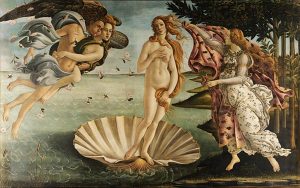Mythology of the Planets
This article titled ‘Mythology of the Planets’ formed part of Module 2 in the Learning Astrology Series and was written by members of the Lifewave Light and Sound Meditation Group in the 1980’s. I have added images to the text and the original document can be viewed below.
HELIOS (Sun)
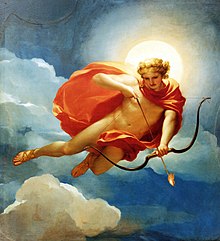 The cult of Helios is very ancient and the island of Rhodes was sacred to him. He is depicted as the all-seeing, all-knowing one and was commonly invoked: in oaths.
The cult of Helios is very ancient and the island of Rhodes was sacred to him. He is depicted as the all-seeing, all-knowing one and was commonly invoked: in oaths.
The myth relates how every morning Helios would emerge in the east from a swamp formed by the river-ocean in the far off land of Ethiopia: His chariot was golden and harnessed with winged horses of dazzling white and flames streaming forth from their nostrils, The God took the reigns and climbed the vaults of the heavens.
He shed his light on gods and men alike. Helios is depicted quite frequently as winged and his head is commonly surrounded by the radiate disk of the sun.
In the Odyssey he is the owner of 7 herds of oxen and 7 flocks of ewes with beautiful fleece teach with 50 in number). This totals 350 and could be an allegory of the days and nights of the lunar year (354 days) and also holds other significance as 7 is an ancient sacred number.
ARTEMIS (Moon)
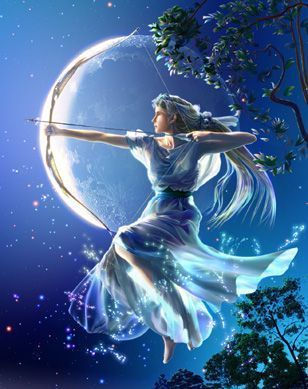 The primitive Artemis was an agricultural deity, worshipped especially in Arcadia. She was goddess of the chase and of forests and was also a divinity of light (the Moon’s light).
The primitive Artemis was an agricultural deity, worshipped especially in Arcadia. She was goddess of the chase and of forests and was also a divinity of light (the Moon’s light).
As Moon goddess Artemis presided over childbirth and was originally a mother deity. She was a protector of young animals and children but was also said to carry a bow and arrow and had the power to send sudden plague and death.
Artemis was Apollo’s twin sister. She could be kindly but was on occasion formidable and any sudden (but not violent) death among women was attributed to a shot from her bow.
The lunar character of Artemis is sometimes recalled on coins by a torch held in her hand, or by the moon and stars which surround her head. Sculptors have emphasised her rural aspect. She was portrayed as a fertility goddess in a tightly sheathed robe covered with animal heads which exposed multiple breasts.
ARES (Mars)
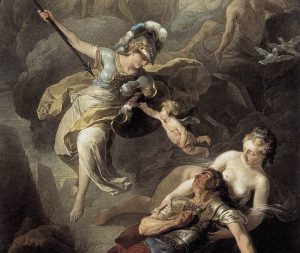 Ares was the God of War and worshipped widely, especially in Sparta. The Greeks disliked purposeless war and this is reflected in the myths of Ares.
Ares was the God of War and worshipped widely, especially in Sparta. The Greeks disliked purposeless war and this is reflected in the myths of Ares.
He was the son of Zeus and delighted in battle for its own sake. He was hated by other gods except Eris, Hades (Pluto), and Aphrodite (Venus). Aphrodite and Ares were in love. Aphrodite, who was married to Hephaestos, was caught together with Ares in his bed. Hephaestos (who was a cripple) was furious and bound them in an invisible net where they could not escape until he wished. He then exposed them both to the ridicule of the gods. It was Helios that had discovered them both together as he missed nothing.
The Greeks thought of Ares with more terror than sympathy and his role was strictly limited. He was simply the god of war, of blind, brutal courage and bloody rage and carnage. He was mounted on a chariot drawn by swift horses with golden brow-bands, clad in bronze armour and grasping in his hands an enormous spear. Ares ranged the battlefield, striking blows on all sides. His two squires, Deimos (Fear) and Phobos (Fright), sometimes said to be his sons, accompanied him.
HERMES (Mercury)
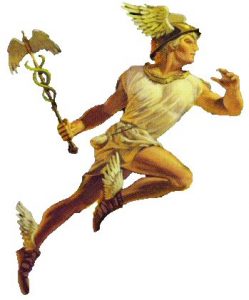 Hermes was the son of Zeus and Maia, born in a cavern on Mount Cyllene in Arcadia and grew as a child with amazing rapidity. When he was only a few hours old he went to Piera and stole some of the oxen of Apollo. He drove the cattle to Pylos and then, returning to Cyllene, he invented the lyre by stringing tortoise shells with cow-gut, making beautiful music.
Hermes was the son of Zeus and Maia, born in a cavern on Mount Cyllene in Arcadia and grew as a child with amazing rapidity. When he was only a few hours old he went to Piera and stole some of the oxen of Apollo. He drove the cattle to Pylos and then, returning to Cyllene, he invented the lyre by stringing tortoise shells with cow-gut, making beautiful music.
Apollo discovered that Hermes had taken the oxen and told Zeus who ordered Hermes to give them back. But Apollo then overheard the lyre and was delighted with its music. He took the lyre in exchange for the oxen and became the friend of Hermes.
Zeus gave Hermes supreme power over animals and appointed him his herald and Hermes was also herald to Hades. He was regarded as God of Eloquence and as heralds were said to promote peace and therefore trade, Hermes came to be looked on as God of Peaceable Commerce.
He was also a god of prudence and cunning (and even of theft). He was said to have helped the Fates in composing the alphabet. Hermes, it was said, invented weights and measures, the musical scale, astronomy, the arts of boxing and gymnastics, and he was also God of Fertility and Luck – therefore presiding over the game of dice.
He was found in Arcadia with Pan and the muses and his attributes were often a travelling hat, wings or winged sandals, and the herald’s staff (or Caduceus) whose white ribbons were later mistaken for serpents when Hermes was acting as herald to Hades.
APHRODITE (Venus)
Aphrodite was the goddess of desire and was worshipped as a fertility goddess. A fertility cult was established as late as the eighth century BC in her honour. She was also a protector of cities. She was also the goddess of beauty (and some say of love) and doves and sparrows were sacred to her.
Aphrodite was said to have sprung from the seed of Uranos (the heavens) and rose naked from the sea. She was the daughter of Zeus. She was said to have married the god Hephaestos, the cripple, but fell in love with Ares by whom she had sons. She had sons also by Poseidon (Neptune), Hermes, Zeus and others.
She possessed a magical girdle which made the wearer irresistibly lovely and desirable and she was envied and admired for her great beauty.
ZEUS (Jupiter)
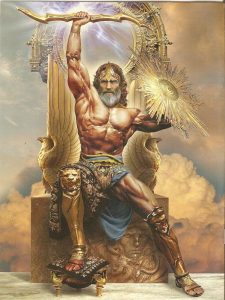 Zeus was the greatest of the Olympian divinities – the omnipotent king of the gods, father of men. He was the bright god of the sky and of atmospheric phenomena. He was also lord of the winds, the clouds, of rain, of thunder (and was depicted as holding the thunderbolt in his hand). He resided in the ether, the upper part of the air, on mountain tops and was literally “all-high”.
Zeus was the greatest of the Olympian divinities – the omnipotent king of the gods, father of men. He was the bright god of the sky and of atmospheric phenomena. He was also lord of the winds, the clouds, of rain, of thunder (and was depicted as holding the thunderbolt in his hand). He resided in the ether, the upper part of the air, on mountain tops and was literally “all-high”.
Later he became the supreme God who united in himself all attributes of divinity. He was omnipotent, seeing and knowing everything, the fountainhead of all divination. He ordained all according to the law of Fate with which his own will was merged. He was a wise sovereign, and to mortals he dispensed good and evil.
He averted threatening dangers, protected the weak, the indigent, the fugitive and in general all suppliants. He was to the family the god of the hearth, of marriage, friendship and of assemblies of people. He was also the protector-god of all Greece.
Normally he was shown as a man in the fullness of maturity, with a robust body, grave countenance and broad forehead, jutting out above deeply set eyes. His face was framed with thick wavy hair and a finely curled beard. He holds a sceptre in his left hand and a thunderbolt in his right hand. At his feet there is an eagle. Sometimes he wears a crown of oak-leaves.
KRONUS (Saturn)
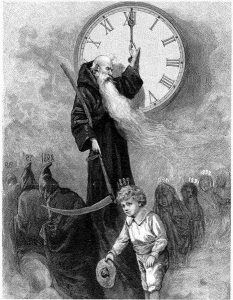 The most popular legend of Kronus shows him married to his sister Rhea. Ge and Uranos warned Kronus that he might be overthrown by one of his own children and he therefore swallowed them as fast as they were born.
The most popular legend of Kronus shows him married to his sister Rhea. Ge and Uranos warned Kronus that he might be overthrown by one of his own children and he therefore swallowed them as fast as they were born.
Rhea, when she gave birth to her youngest child, Zeus, carried him away and gave Kronus a stone wrapped in swaddling-clothes instead.
Thus Zeus grew to maturity and soon raised a power against his father. Matis, the daughter of Oceanus, counselled Zeus and with Rhea’s help gave Kronus a potion which ‘obliged him to disgorge’ first the stone and then his other children, Hestia, Demeter, Hades, Hera and Poseidon, who then joined with Zeus in opposition against his father.
The earlier legends show him to be a far kindlier, more fatherly figure. He was represented in art as a majestic and sorrowful old man, holding a curved object which might have been a reaping hook. Under his rule, all was innocent happiness. Men lived long and virtuous lives, having all things in common and having abundance of the earth’s own produce. This was said to be a Golden Age.
POSEIDON (Neptune)
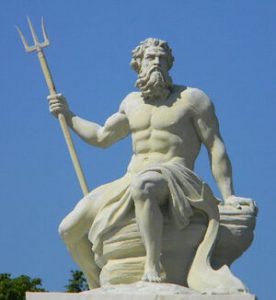 Poseidon was depicted in earlier myths as ‘the Earthshaker’ with a horse that thundered the earth; the early invaders of Greece (the Minyans and Ionians) said that it was due to the help of their god, Poseidon, that they had won their battles.
Poseidon was depicted in earlier myths as ‘the Earthshaker’ with a horse that thundered the earth; the early invaders of Greece (the Minyans and Ionians) said that it was due to the help of their god, Poseidon, that they had won their battles.
Later (in about 1450 BC) Poseidon was said to be the older brother of Zeus and a sea-divinity. Eldest son of kronus and Rhea, after the disposition of Kronus, he and his brothers Zeus and Hades cast lots for sovereignty, and the sea became Poseidon’s share. He dwelt in an underwater palace near Aegae and here he kept his horses with brazen hooves and golden manes. When they drew his chariot over the sea it became tranquil.
He was known as protector of the horse and chariot races. He held the symbol of power, the Trident, possibly in origin a thunderbolt, by means of which he could shake the earth or subdue the waves. Now this is a symbol of sea-power. Usually he was accompanied by Amphitrite (his wife), Triton (his son), Nereids and dolphins.
ORIGIANL DOCUMENT

